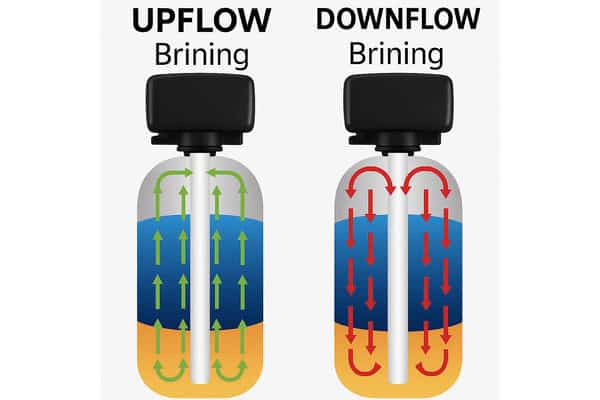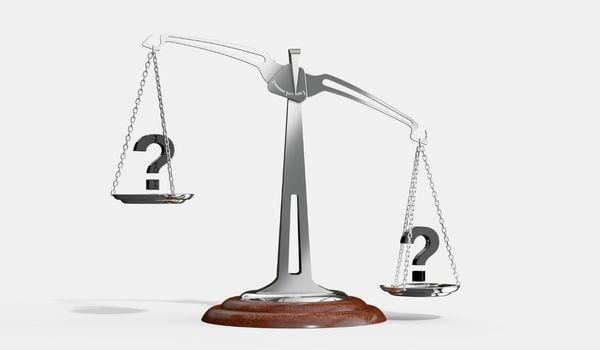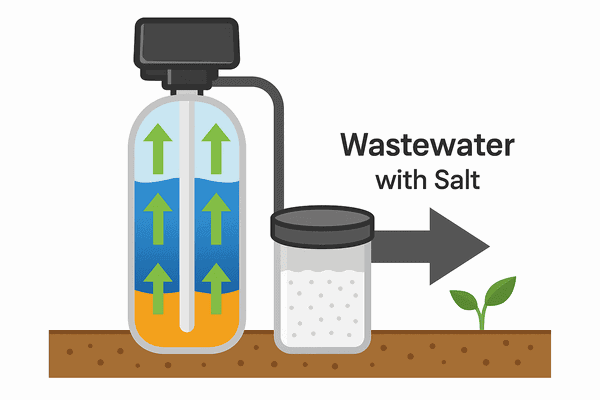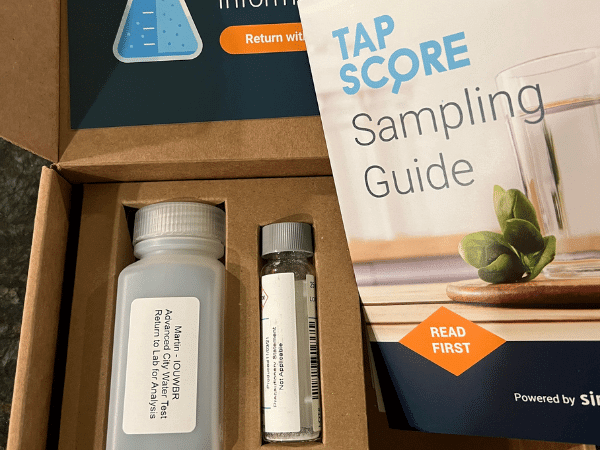💡 Quick Fact: Upflow systems don’t just save salt — they keep resin beads from hardening, preventing clogs that can kill your softener’s lifespan.
Upflow systems might look like the hero — saving salt, reducing waste, and boosting efficiency. But without a sediment pre-filter, they can clog faster than a downflow model. Downflow systems are easier to install and more forgiving, but they’ll burn through more salt over time.
Choosing the right flow direction could mean the difference between smooth sailing or constant maintenance.
📝 Key Takeaways:
- 🧪 Test First: Know what’s in your water — iron, sediment, or minerals can change which softener works best.
- 🌀 Upflow Systems: Great for saving salt and cutting waste, but they need cleaner water to avoid clogging.
- 🌊 Downflow Systems: Easier to install and less picky about water quality, but they burn through more salt.
- 💸 Cost vs. Maintenance: Upflow costs more upfront but can save you in the long run. Downflow is cheaper to start but could mean more refills.
- 🛠️ Pro Tip: Match the softener to your water type — well water needs a different setup than city water.

🌀 Why Upflow?
Upflow water softeners send water through the resin bed from bottom to top, forcing hard minerals up and out. This reverse flow design minimizes salt waste and extends the lifespan of the resin — but it’s not a perfect system. If your water has heavy sediment or iron, the upward flow can stir up debris, leading to clogs without a sediment pre-filter.
Benefits of Upflow Systems:
- ✅ Salt Saver: Uses less salt by optimizing the resin bed.
- ✅ Water Efficiency: Reduces wastewater by targeting hard minerals more precisely.
- ✅ Longer Resin Life: Less salt means less strain on the resin beads.
Potential Drawbacks:
- ⚠️ Clogging Risk: High sediment levels can choke the system.
- 💧 Higher Upfront Cost: The advanced design comes at a premium.
🧐 Good to know: If your water has visible sediment or heavy iron, install a spin-down filter before the upflow system to prevent clogging.
🌊 Why Downflow?
Downflow softeners send water from the top down, allowing gravity to do the work. This traditional design is less sensitive to sediment buildup, making it more forgiving for well water or older plumbing. However, the straightforward flow pattern can waste more salt and water during regeneration.
Benefits of Downflow Systems:
- ✅ Simple Setup: Easier to install, even for DIYers.
- ✅ Sediment-Friendly: Less prone to clogging — good for untreated well water.
- ✅ Lower Cost: Typically more affordable than upflow models.
Potential Drawbacks:
- ⚠️ Salt Hog: More salt needed to recharge the resin bed effectively.
- 💧 Higher Water Waste: Regeneration cycles can be less efficient, increasing water usage.
📌 Take note: If your water has iron or sediment, a downflow system may be more forgiving — but expect to use more salt over time.
🔄 Upflow vs. Downflow: Side-by-Side Comparison

Upflow systems sound great on paper — they’re designed to save salt and reduce water waste. But if your water has a lot of sediment, the upflow process can stir up debris and lead to clogs. Downflow systems, on the other hand, work with gravity and are less likely to get jammed up. The trade-off? They use more salt and water over time.
| Feature | 🌀 Upflow | 🌊 Downflow |
|---|---|---|
| 💧 Water Flow Direction | Bottom to top | Top to bottom |
| 💰 Upfront Cost | Higher — advanced design | Lower — traditional setup |
| 🛠️ Maintenance Needs | Requires sediment pre-filter | Handles sediment better |
| 💦 Salt Efficiency | Less salt waste | More salt needed |
| 🌱 Environmental Impact | Less wastewater | Higher water usage |
| 🚿 Best For | Low sediment, light mineral content | Well water, high sediment |
💡 Pro Tip: If your water has heavy iron or visible particles, downflow is usually a safer bet. But if you’re on city water with minimal sediment, upflow can save you on salt and water costs.
🌱 Environmental Impact & Salt Discharge

The way a softener handles salt and water waste can have a bigger impact than you’d think — especially if you’re on a septic system or dealing with water restrictions. Some systems are designed to cut down on both, while others might use more salt but waste less water. And with new regulations popping up, choosing the right setup can save you more than just a few bucks.
- Salt Discharge: Upflow systems use less salt per cycle, reducing discharge — ideal for septic systems and drought-prone areas.
- Water Waste: Downflow models tend to use more water during regeneration, which can add up if you’re on a well or have water restrictions.
- Eco-Friendly Alternatives: Look for systems with demand-initiated regeneration (DIR) or salt-free conditioners for lower environmental impact.
💡 Pro Tip: If you’re on a septic system, go for a system with a salt discharge setting to avoid overloading the tank.
🧪 Why Water Testing Matters

Upflow or downflow — it all comes down to what’s actually floating around in your water. If it’s loaded with sediment, iron, or heavy minerals, that’s going to change how well each system does its job (and how often you’ll need to mess with it).
| Test Type | What It Detects | Why It Matters |
|---|---|---|
| 💧 Hardness Test Kit | Calcium and magnesium levels (GPG) | Helps determine salt usage and resin capacity needs |
| 🧪 Iron Test | Iron concentration (PPM) | High iron can clog upflow systems without a filter |
| 🌀 Sediment Test | Suspended particles and turbidity | Indicates whether a spin-down or cartridge pre-filter is necessary |
| 🌿 Chlorine/Chloramine Test | Chlorine and chloramine levels | Excess chlorine can degrade resin beads faster |
| 🔬 Comprehensive Water Analysis | Minerals, bacteria, pH, heavy metals | Reveals potential resin fouling risks and filter compatibility |
📌 Take Note: Water testing kits can reveal more than just hardness levels. Check for sediment, iron, and chlorine to determine whether a pre-filter or iron filter is necessary.
🔍 Which System Is Best for Your Water Type?

Not all water is created equal. Hard water, well water, and city water each have their quirks — and so do upflow and downflow softeners. Here’s how they stack up based on water type:
| Water Type | 🌀 Upflow | 🌊 Downflow |
|---|---|---|
| City Water (Low Sediment) | Best Choice: Saves salt and water Tip: Install a sediment pre-filter for added protection | Not Ideal: Less efficient, higher salt use |
| Well Water (High Sediment) | Risk of Clogging: Needs a strong pre-filter | Best Choice: Handles sediment without clogging |
| Hard Water (Over 7 GPG) | Good Choice: Saves salt, but may need frequent regeneration | Good Choice: Effective but uses more salt |
| Eco-Conscious (Low Water Use) | Best Choice: Less water waste during regen | Not Ideal: Uses more water and salt |
📌 Take Note: If your water is heavy in iron or sediment, a spin-down filter is a must with upflow systems. Otherwise, downflow will handle it better without the clog risk.
🏠 Flow Rate & Sizing
Choosing the right flow rate and system size isn’t just about how many people live in the house — it’s about how you use water. If everyone showers in the morning or you run multiple appliances at once, a standard 10 GPM system might not cut it. And if your water is loaded with iron or sediment, a smaller system will likely struggle to keep up. Here’s how to match the right flow rate and capacity to your specific needs.
- Single Family Home (2–4 People): Aim for 1.5–2.0 cubic feet of resin with a flow rate of 10–12 GPM. Ideal for moderate hardness and average water usage.
- Large Household (5+ People): Go for 2.5–3.0 cubic feet of resin with 15–20 GPM flow to prevent pressure drops.
- Small Apartment/Condo: A 1.0 cubic foot system with 8–10 GPM flow is usually sufficient for light use and minimal hardness.
- Well Water vs. City Water: If your water is heavy with sediment or iron, consider sizing up to prevent frequent regenerations.
- High-Demand Scenarios: Hot tubs, multi-bathroom homes, or multiple appliances running simultaneously? Bump up the flow rate to 20+ GPM to avoid pressure loss.
💡 Pro Tip: Sizing too small leads to constant regenerations, higher salt costs, and reduced resin lifespan. Better to oversize slightly than undersize.
💸 Maintenance & Cost

When it comes to water softeners, the initial price tag is only part of the equation. Salt, filters, and routine maintenance can add up over time — and some systems are cheaper to run than others.
Upflow models tend to use less salt but may require more frequent cleaning if sediment is an issue. Downflow systems are simpler to maintain but can burn through salt faster.
Let’s look at what to expect:
| Aspect | 💵 Upfront Cost | 🔄 Maintenance Frequency | 💰 Annual Cost |
|---|---|---|---|
| 🌊 Downflow System | $600–$1,000 | 🧂 Salt refill every 6–8 weeks 🔍 Resin check annually |
$100–$150 |
| 🌀 Upflow System | $1,200–$1,800 | 🧂 Salt refill every 10–12 weeks 🔍 Resin check every 2 years |
$75–$120 |
| 🧪 Iron/Sediment Pre-Filter | $150–$300 | 🛠️ Filter change every 3–6 months | $50–$75 |
| 📱 Bluetooth Monitoring | $200–$400 (Add-on) | 🔧 App updates, firmware checks | Minimal |
📌 Take Note: A higher upfront cost can pay off in the long run if it means less salt and water use. For households with heavy iron or sediment, factor in pre-filter maintenance as a recurring expense.
🚨 Common Mistakes to Avoid

Water softeners might look straightforward, but the wrong setup can turn into a costly headache. Here’s what most people get wrong — and how to avoid it:
Underestimating Flow Rate:
Going too small on grain capacity to save money? Bad move. A 1.0 cu. ft. system might handle daily use, but throw in laundry day and a couple of showers, and you’re looking at a pressure drop — or worse, hard water sneaking through untreated.
💡 Pro Tip: Size up by 0.5 cu. ft. if you’re running multiple appliances at once or have more than 4 people in the house.
Skipping the Water Test:
It’s tempting to guess your hardness level or assume iron isn’t an issue — until your upflow softener starts clogging with rust.
🧪 What to Do Instead: Spend $30 on a complete test kit. Look for:
- Hardness
- Iron
- pH
- Chlorine levels
📌 Take Note: If iron is over 0.3 ppm, add a pre-filter or iron filter to protect the resin bed.
Ignoring Pre-Filters for Upflow Systems:
Upflow systems save salt but hate sediment. Without a spin-down filter, you’re asking for clogs and resin fouling.
🔍 Insider Insight: If you’re on well water, a dual-stage sediment filter (spin-down + cartridge) will keep your upflow system running smoothly.
Assuming All Salt is the Same:
Not all salt pellets are created equal. Low-quality salt can gunk up the resin bed, leading to poor softening and more frequent regenerations.
💡 Pro Tip: Look for 99.8% pure salt pellets or solar salt — they dissolve cleaner and extend resin life.
Neglecting System Settings:
Default settings are rarely optimized for your water. Failing to adjust regen cycles or salt dosage can waste both.
🛠️ Fix It: After 30 days of use, run another hardness test. Adjust salt dosage based on actual usage, not the default.
💡 Good to Know: Many systems are factory-set for city water, not well water. If your water has both high iron and sediment, consider a dual-tank system or a hybrid model that softens and filters simultaneously.multaneously.
✅ Final Thoughts
Choosing between upflow and downflow systems isn’t just about salt savings or water usage — it’s about what’s actually in your water and how each system handles it. If you’re dealing with iron-heavy well water, a downflow model may be the safer bet to prevent clogs. On the other hand, if your focus is on reducing salt waste and keeping monthly costs down, upflow systems with advanced resin can be a solid investment.
For a deeper dive into specific products that fit your water type and budget, check out these guides:
- 🏡 Top Water Softeners for Every Home Setup — a complete look at top-rated upflow and downflow systems.
- 🚿 Well Water Solutions — if you’re dealing with iron, sulfur, or sediment, this guide breaks down systems designed to tackle common well water issues.
- 🌱 Salt-Free Alternatives — considering a salt-free option? Here’s a closer look at conditioners that reduce scale without salt.
💡 Pro Tip: Before making a final decision, run a complete water test to identify sediment, iron, and hardness levels — it’s the simplest way to ensure you’re getting the right system for your water.
 98 people found this helpful. Was this guide helpful to you?
98 people found this helpful. Was this guide helpful to you? 

